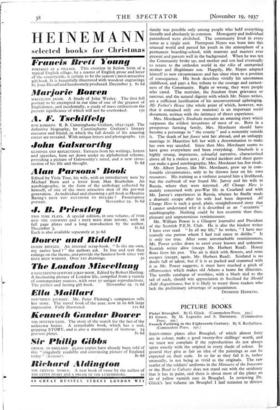PICTURE BOOKS
French Painting in the Eighteenth Century. By S. Rocheblave. (Commodore Press. 25s.)
SIXTY-THREE plates after Brueghel, of which almost forty are in colour, make a good twenty-five shillings' worth, and we must not complain if the reproductions do not always agree exactly with the original in every shade of colour. In general they give as fair an idea of the paintings as can be expected on their scale. In so far as' they fail it is, rather unusually, in not being as vivid as the originals. The raw scarlet of the soldiers' uniforms in the Massacre of the Innocents or the Road to Calvary does not stand out with the stridency that it has in paint, and there is about most of the plates an air of yellow varnish rare in Brueghel. In reviewing Dr. Gliick's last -vortun-d.-,on Brueghel I hod—occasion to discuss the chronology of the artist, and to state on what points I differed from the writer. In the present volume there are so many matters of interpretation which appear to me disputable that it would take a full-length review to deal with them. Perhaps I should challenge most strongly Dr. Gliick's state- ment that Brueghel is never a didactic artist. I should not maintain that he is always so, but in the early engravings (which incidentally must have been intended for a wider public than Dr. Gluck will allow) both titles and • treatment hardly seem to leave the matter in doubt. There are so many mistakes in the text that one can only assume that thi proofs were not read at all.
The El Greco volume is far more serious in intention. Its plates almost reach 50o in number and they present the only corpus of Greco's work, apart from Dr. Mayer's preposterously expensive book. It is true-that many paintings are reproduced which can hardly be more than studio versions, but that does not much detract from the value of the book, since it gives a means of judging the whole oeuvre of the master and his immediate copyists. There is only one incomprehensible omission, namely, that of the Modena tryptych, at present to be seen at the Greco exhibition in Paris, Which is by far the most important document for the early period of the painter. The text gives a fair account of El Greco's life, though as usual the influence of Roman Mannerism on his early style is not sufficiently emphasised. The dating is also in general sensible, though certain entries are baffling, such as that on plate xv : " Last Period-1571-1576," when the artist died in 1614, and painted to the day of his death.
M. Rocheblave's volume is a companion to his book on nineteenth-century French painting, of which it has all the merits, particularly that of being representative and of not only showing the works of painters at the moment in fashion. At most we can regret, from this point of view, that there is no big scene by Greuze and that Carle van Loo's baroque histories are not represented. Otherwise the choice is admirably balanced. The text is short, but M. Rocheblave knows hOw to pack a great deal' of infoniation into a small space, and the result is one of the best accounts available of the painting of the period. It would have been considerably more readable if the translation had been purged of some bad grammar, and some bad words, such as Naturist, lyrism and civisrn, which may do in French, but which grate badly in English. There is even an efficient bibliography, from which we only regret the absence of Mlle. Humbert's recent brilliant book on David. It is hardly necessary to
add that there are a few misprints. ANTHONY BLUNT.

















































































































 Previous page
Previous page